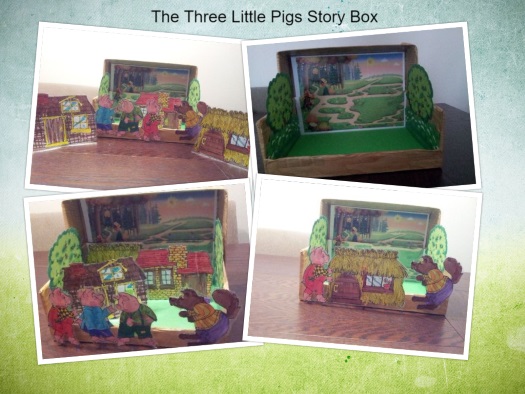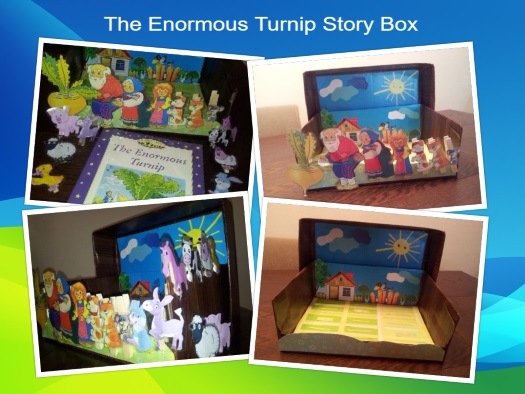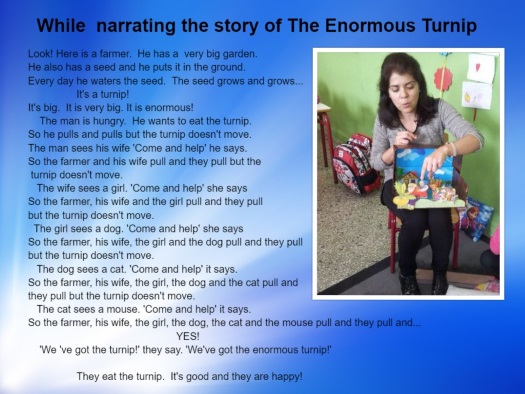The Story Box: Dramatised Storytelling Activities for Young Learners
Angeliki Voreopoulou, Greece
Angeliki Voreopoulou has been an ELT practitioner since 1998. She is currently working in a State Primary school in Northern Greece. She has won a prize for implementing board games in teaching English to very young learners at the Day Conference on Early Language Learning organized by the Greek ministry of Education and the University of Athens. She stimulates her students’ creativity by engaging them in projects fostering critical thinking, collaboration and communication. She shares her practice in seminars, talks and workshops. Her main interests include visual materials, storytelling and the use of Web 2.0 tools into the classroom. E-mail: avoreopoulou@hotmail.com

Menu
Introduction
What is a Story Box?
Narrating with the Story Box
Games accompanying ‘The Enormous Turnip’ Story Box
Storytelling is an ancient art that has survived and developed throughout the centuries because it nurtures both the mind and the heart of the listeners. No particular equipment is necessary to create images… just the speaker’s voice and the listener’s imagination. Stories carry cultural information, customs and they have been used as a way of passing down beliefs, traditions and values to future generations. At the same time, stories depict universal topics like love, friendship, pain, poverty which make the listeners realise that they have more things in common with the ‘others’ than differences. As a learning tool, educators have long exploited storytelling as a way to increase students’ motivation, to help learners communicate their thoughts and feelings and to develop empathy. Language teachers in particular, use story telling as a method to improve reading, writing, speaking and listening skills while enhancing vocabulary and grammar structures. It is a method to provide an enjoyable and authentic context that allows learners to get fully involved in the language learning process and at the same time to unleash their creativity and imagination.

A story box is nothing more than a simple shoe box designed in a such a way so as to include all the components needed for the teacher – storyteller and for the learner-audience. The setting/scene of the story, some props and the main characters can be crafted in advance or can be downloaded from the Internet. Wooden or plastic pegs can be used to make the heroes of the story standing while the teacher or the students narrate the story. It resembles a puppet theatre, but it is more convenient - it can be stored easily and reused multiple times as it requires no preparation time… everything will be in the box!
The storybox provides a simple and unsophisticated way to integrate a variety of creative arts like storytelling, drama activities, singing, poetry and crafts in a lesson with a unique purpose: to cater for the needs of different learning styles and interests. It can prove to be extremely useful when teaching very young learners because it allows the teacher to incorporate many different activities that can attract young learners’ attention and maintain their interest high despite their limited attention span.
The following lesson outline is inspired by the story of ‘The Enormous Turnip’. It is a story about the value of working together and helping each other. At the same time, it provides an opportunity for language learners to revise farm animals and to practice their narrative skills because the storyline is based on a repetitive pattern suitable for very young learners.

Language Level: Elementary (A1)
Ages: 6-8 years old
Time: 60 minutes
Topic: The Enormous Turnip
Language: Vocabulary related to farm animals, colours
Language Skills: Following orders, learning how to narrate a story
Materials: A story box inspired and designed using the heroes and the setting of the story
Flashcards with farm animals, A print out poster representing a farm
Procedure:
Before narrating the story
- The teacher uses the flashcards to pre-teach and/or revise farm animals by encouraging students to repeat the animals after him/her and by accompanying the animal related words with a movement or the sound animals make.
- Students sit comfortably in a circle. They can use their cushions and sit on the floor.
- The teacher shows students the story box and asks them to predict the story they are going to listen.
While narrating the story
- The teacher starts narrating and uses a simple version of the story suitable for the students’ language level.
- The second time the teacher narrates the story the learners can join the teacher by adding the animals which are willing to help the farmer pull out the turnip.
- Every time a new hero appears the teacher urges the students to name all of the heroes from the beginning and to perform the act of pulling altogether.
- The teacher can add as many farm animals as she/he wants students to revise.

After narrating the story
‘Making a classroom poster based on the story and acting out the main scenes’
- The teacher gives each student a farm animal in a form of a paper puppet.
- Students listen to the teacher who dictates the colour of each animal. For example, ‘Colour the dogs black’, ‘Colour the ducks yellow’ etc
- When all students have coloured their puppet farm animal, they prepare themselves for placing it on the classroom poster.
- The teacher encourages students to narrate the story again.
- Each time a new animal is introduced, a student stands up, sticks his/her animal on the poster and gets in the line with the rest of the students pretending to be pulling the turnip.
- By the end of the activity, the students will have made a poster based on the story of "The Enormous Turnip" and they will have acted out the story while narrating the main parts of it.
The following activities are games adapted to accompany the story of ‘The Enormous Turnip’. They can be used anytime when there are five minutes left and they provide great opportunities for revision and moments full of fun and joy!
a) The Runaway Animals
Language Level: Elementary (A1)
Ages: 6-8 years old
Time: 5 minutes
Topic: The Enormous Turnip
Language: Vocabulary related to farm animals,
Language Skills: asking and answering simple questions
Materials: Farm animal flashcards or masks
- The teacher informs students that the farm animals have run away. The farmer and his wife will try to find them and bring them back home safely. However, all animals will have to answer correctly a question that the farmer or his wife will make to them.
- Two of the students pretend to be the farmer and the wife whereas the rest of the class pretend to be a farm animal. To make it more realistic, students wear farm animal masks or they hold a farm animal flashcard.
- The students with the animal flashcards scatter in the classroom and wait for the farmer or the wife to ask them a question.
- The farmer and his wife try to find the runway animals by competing each other. When they reach a student they ask him/her:
- “What’s your name?’
- “I’m a cow/ dog / chicken. My name is….” replies the student and then s/he stands behind the farmer or the wife depending on who has posed the question.
- The aim of the game is to find as many animals as possible and ask as many questions.
- The winner is the hero (farmer or wife) with the most runaway animals standing behind him/her.
b) Farm Animal Sounds
Language Level: Elementary (A1)
Ages: 6-8 years old
Time: 5 minutes
Topic: The Enormous Turnip
Language: Vocabulary related to farm animals
Language Skills: Listening and responding to new vocabulary
Materials: Farm animal flashcards and a CD player
- The teacher puts farm animal flashcards on the floor.
- Students have to walk around the classroom while they listen to the music.
- When the music stops, they have to stand next to the flashcard they are the closest to.
- The teacher calls out the name of an animal. The students who stand next to this flashcard start making the sound of this animal.
c) Help me cross the farm in four steps
Language Level: Elementary (A1)
Ages: 6-8 years old
Time: 5 minutes
Topic: The Enormous Turnip
Language: Vocabulary related to farm animals
Language Skills: Listening and responding to new vocabulary
Materials: Farm animal flashcards
- The teacher tells the students that the farmer has lost his way to the farm and he cannot get back home before sunset. His wife will help him find his way.
- The students get in pairs (farmer-wife) and the teacher puts some farm animal flashcards on the floor.
- The students stand opposite each other across the classroom.
- The wife calls out the names of four farm animals slowly. The farmer has to step on these flashcards so as to find his way back home.

Please check the Creative Methodology for the Classroom course at Pilgrims website.
Please check the Methodology and Language for Kindergarten course at Pilgrims website.
Please check the Methodology and Language for Primary course at Pilgrims website.


|